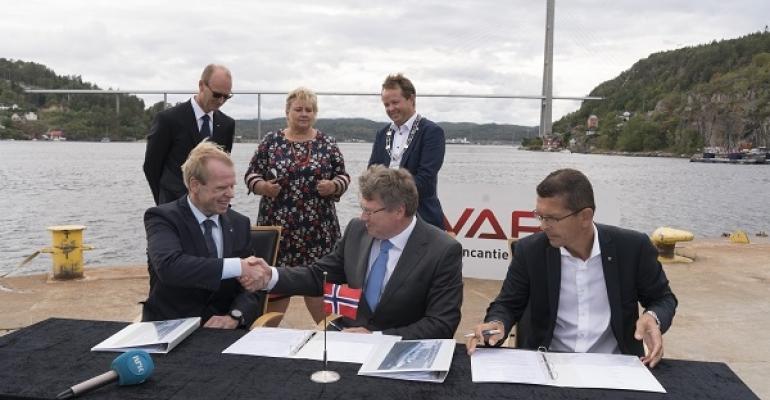The Yara Birkeland is scheduled to be delivered from Vard Brevik in Norway in the first quarter of 2020 and the vessel will gradually move from manned operation to fully autonomous operation by 2022. The hull will be delivered from Vard Braila in Romania.
Yara and technology company Kongsberg announced a partnership In May 2017 to build the vessel, which will replace 40,000 truck journeys a year. Yara Birkeland will reduce NOx and CO2 emissions and improve road safety in a densely populated urban area.
“A vessel like Yara Birkeland has never been built before, and we rely on teaming up with partners with an entrepreneurial mindset and cutting edge expertise. Vard combines experience in customized ship building with leading innovation, and will deliver a game-changing vessel which will help us lower our emissions, and contribute to feeding the world while protecting the planet,” said Yara president and ceo Svein Tore Holsether.
With the vessel, designed by Marin Teknikk, now being assigned to a yard to be built, the groundbreaking project is well on its way to fruition. The Norwegian technology company is responsible for the enabling technologies onboard, including the sensors and integration required for remote and autonomous operations. In May, Yara signed a deal with Finnish company Cargotec’s cargo handling solutions unit Kalmar to deliver fully autonomous equipment, software and services for a unique, fully digitalised container handling solution at the facility.
Read More: Kalmar to provide landside equipment for Yara Birkeland project
Vard ceo and ed Roy Reite commented: “We are honored to be chosen as Yara’s partner in this innovative and exciting project. With longstanding experience in building state-of-the-art and tailor-made specialized vessels, we are excited to be given the opportunity to build the world’s first autonomous and electric-driven container vessel. It is a pleasure to welcome Yara and Kongsberg to Vard, and we look forward to working closely with all parties involved.”
The project has received NOK133.6m in support from the Norwegian government enterprise Enova. “This is a good example of how Norwegian industry can collaborate to create new solutions and green jobs,” said Norwegian prime minister Erna Solberg the signing at Vard’s Brevik yard in Norway.
“Yara, Kongsberg and Vard have built on their knowledge about technology, logistics and ship building with an ambition to create sustainable innovation together. The result is exciting pioneer projects like this one. I am proud that the Government has supported the development of Yara Birkeland through Enova and send my best wishes for the construction,” added Solberg.
Read More: Wilhelmsen and Kongsberg setting up world's first autonomous shipping company
“Yara Birkeland represents an important next step for the entire maritime industry, representing a major technological and sustainable advancement. The Norwegian maritime cluster has taken a leading position within technology, design, legislation, testing and all other aspects of the development,” said Kongsberg ceo Geir Håøy.
The project was initiated in an effort to improve the logistics at Yara’s Porsgrunn fertilizer plant, where more than 100 diesel truck trips are made daily from the plant to ports in Brevik and Larvik where Yara exports its products. The new autonomous battery-driven vessel is meant to transfer these movements to sea transport and thereby reduce noise and dust emissions, improve the safety of local roads, and reduce NOx and CO2 emissions.
Copyright © 2024. All rights reserved. Seatrade, a trading name of Informa Markets (UK) Limited. Add Seatrade Maritime News to your Google News feed.


